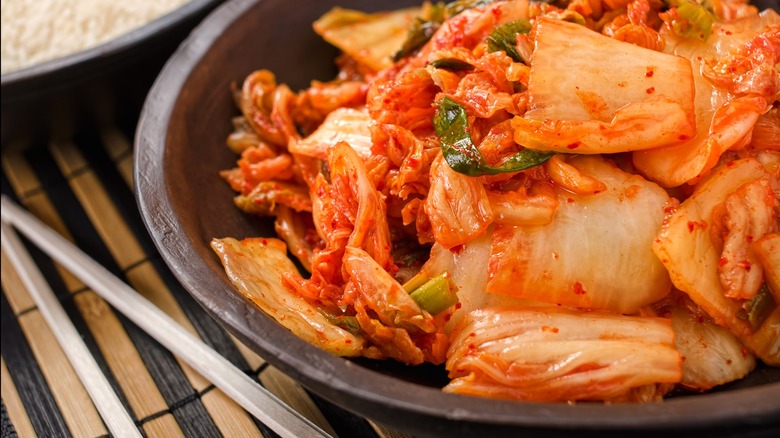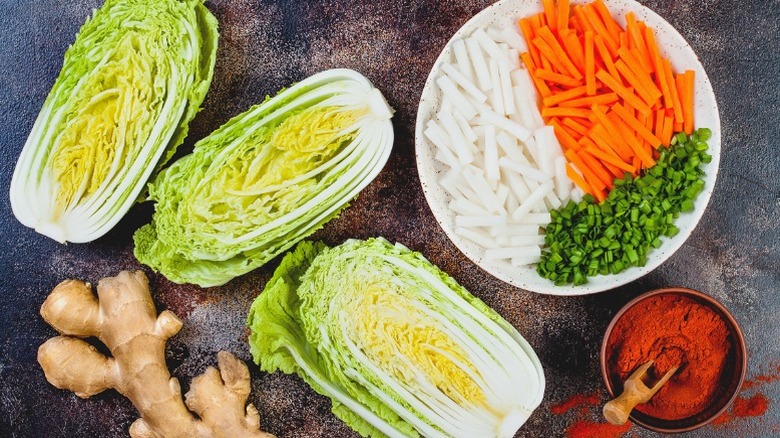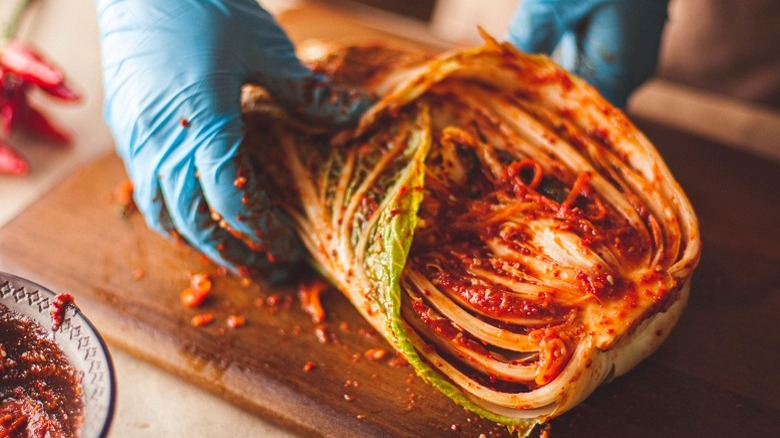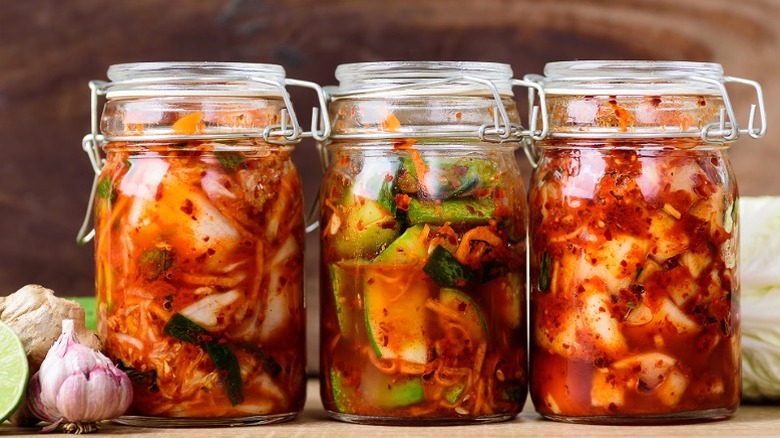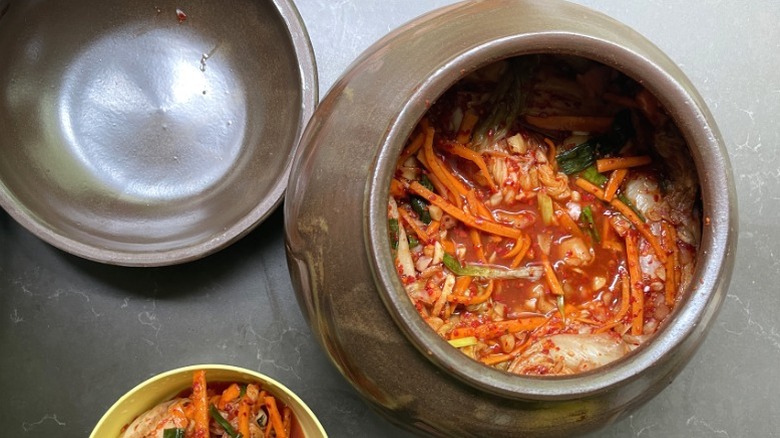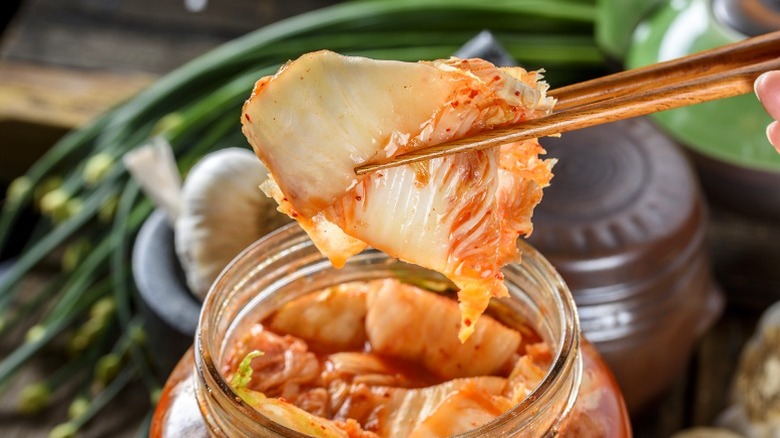5 Expert Tips For Making The Ultimate Homemade Kimchi
The United States has a growing appetite for Korean cuisine. According to research by Circana, Korean restaurant locations in the U.S. went up by 10% in 2024, with the kimchi dish seeing an 80% increase in popularity. There's no reason for these food trends to slow down in 2025, so we'll likely be seeing a lot more folks making their own kimchi at home.
Kimchi, in some shape or form, has existed for thousands of years. It was invented as a way to store vegetables through the winter, and ancient people found that fermentation imparted a delicious and unique flavor to the produce. The techniques have evolved with time, but the heart remains the same: Kimchi is made up of vegetables that have been slowly fermented in a marinade while sealed in a container.
If you're new to Korean cuisine or looking for a way to switch up your usual veggie routine, kimchi is a fantastic place to start your cooking journey. To help you prepare this recipe at home, Chowhound consulted Sungchul Shim, the chef and owner of Mari and Kochi in New York, where his Korean dining menu has earned a Michelin star. He's shared with us some pointers that you can apply while following along with our own classic napa cabbage kimchi recipe.
Tips for preparing cabbage for tongbaechu kimchi
Tongbaechu translates to "whole cabbage," which is the star vegetable for kimchi. The type of cabbage you'll want to use is napa. It grows into an oblong shape with a white stalk, as opposed to the dark green sphere cabbages. Napa cabbage is sweeter, and its stalk provides a sturdy, crunchy base for the paste. Once you've cut it into chunky 1 to 3-inch pieces, you'll want to salt it. With your mise en place ready to go, you can now start the process.
According to chef Sungchul Shim, you'll need to rinse the cabbage after salting to remove the excess. Lightly pat the leaves dry so that when they're ready to take the paste, it doesn't turn watery. "Start from the outer leaves and work inward, applying the paste evenly to each leaf," he said. "Use gloved hands to gently massage the paste into every fold for thorough coverage."
Adjusting kimchi flavor
The paste for kimchi is a mix of minced garlic, grated ginger, gochugaru, sugar, fish sauce, and water. Most of the time, side vegetables like julienned carrot and sliced green onion are added to the paste for texture. Adjust these quantities to your liking, and it'll determine the end flavor. These are raw ingredients you can taste as you work.
If your kimchi is a little too spicy, Chef Sungchul Shim recommended adding slices of crunchy radish, pear, or extra cabbage to balance the spice during fermentation. Conversely, if you want more spiciness and less sweetness, he suggested putting in more brined vegetables or salt. He said, "After fermentation, use overly spicy or sweet kimchi in stews, soups, or fried rice to mellow the flavors."
Ideal container for fermenting kimchi
Chef Sungchul Shim said that the best container for fermenting kimchi is a traditional clay onggi. The onggi is the traditional clay jar used for making this dish. In his professional opinion, it's "ideal for air circulation but not essential."
Kimchi should be stored in an air-tight container to ensure an uninterrupted fermentation process. Glass jars with a suction lid seal will work as an alternative to the onggi. Just place a weight on top and keep an eye out for overflow from the fermentation gasses.
When it comes to storage temperature, the fresh kimchi should ferment at room temperature for a day. This will accelerate how quickly the kimchi ferments and establishes the ideal conditions for microbial cultures. Cold storage decelerates the fermentation and creates a longer shelf life, so after a day, transfer the jar of kimchi to the refrigerator, where it'll be at its peak for about a week.
How to tell if your kimchi is fermenting properly
"A slimy texture, foul odor, or black mold are clear signs of spoilage," advised Sungchul Shim. He believes that a good fermentation process is characterized by small bubbles, a tangy aroma, and a slightly translucent appearance in the cabbage. Conversely, it also may produce a white, yeast-like film on the surface that he said was harmless and can be removed and discarded.
While kimchi is a fermented, not pickled food, it should end up with a very mild vinegary smell despite not including it as an ingredient. This is because the bacteria will work to convert carbohydrates into lactic acid, creating that sour flavor you're looking for. The microbial culture will produce carbon dioxide, making the liquid bubble as a sign it's doing its job.
Knowing when kimchi is ready to eat
One rookie mistake people make with homemade kimchi is over-fermentation. It'll have a mushy texture as opposed to a soft and crunchy one. The taste will be stronger than normal and can taste too sour or vinegary for many people. If it's too fermented for your tastes, there are ways to repurpose kimchi by incorporating it into a stew or pancake-style dish called kimchi jeon.
The sweet spot for most people when it comes to eating kimchi is about three to five days, but it all depends on taste preferences. At its peak, it'll be ready to eat when it tastes tangy, slightly sour, and still has a firm texture. This dish is delicious on its own but shines as a side dish or ingredient to serve with other foods. Use it to top noodles and rice or make a fusion dish by pairing it with tacos and sub sandwiches. With this expert advice under your belt, you'll be able to appreciate this iconic Korean staple at home without any worries.
